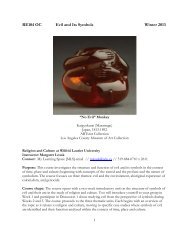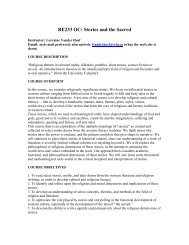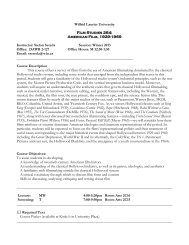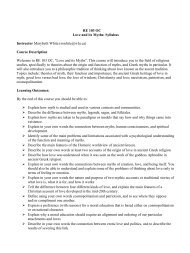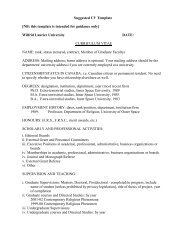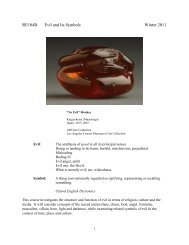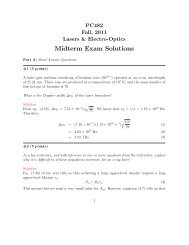Registration Guide for Year 1 Students - Wilfrid Laurier University
Registration Guide for Year 1 Students - Wilfrid Laurier University
Registration Guide for Year 1 Students - Wilfrid Laurier University
Create successful ePaper yourself
Turn your PDF publications into a flip-book with our unique Google optimized e-Paper software.
Glossary of common university termsAcademic TermThere are five academic terms in the calendaryear:Fall (12 weeks) September - DecemberWinter (12 weeks) January - AprilSpring (12 weeks) May - AugustIntersession (6 weeks) May - JuneSummer (6 weeks) July - AugustFull-year courses - run September to Apriland are marked with an *, they will say “IP”in the fall term as the course is not completeduntil April.Note: The number of weeks listed above <strong>for</strong>each term are teaching weeks. Final examsfollow.Academic <strong>Year</strong>The academic year in the undergraduatesystem consists of two terms (totallingan eight-month duration), typically fromSeptember to April. Specific years arenormally classified as <strong>Year</strong> 1 (0.5 to 5.0credits), <strong>Year</strong> 2 (5.5 to 10.0 credits), <strong>Year</strong> 3(10.5 to 15.0 credits), <strong>Year</strong> 4 (honours studentswith 15.5 to 20.0 credits), <strong>Year</strong> 5 (doubledegree students with 20.5+ credits) and areused to indicate the academic level at which astudent is studying.AttemptAny course <strong>for</strong> which a final grade has beenassigned, including a failed grade.Blackboard Learning System (<strong>for</strong>merly WebCT)<strong>Wilfrid</strong> <strong>Laurier</strong> <strong>University</strong> uses BlackboardLearning Systems (<strong>for</strong>merly WebCT) as itsLearning Management System (LMS) <strong>for</strong>delivery of distance education courses aswell as <strong>for</strong> support in classroom courses. TheLMS allows instructors and administratorsto organize and manage course content andstudents in an online environment. WebCTtechnical problems, passwords etc. should bedirected to Teaching Support Services, ext.4722.Closed CourseCourses that have reached their limit <strong>for</strong>space.Course (Half-credit and Full-credit)A unit of study in a given discipline identifiedby a unique number and name in a givendepartment. The weight of value of a course isdefined as follows: a 1.0 credit (or full-credit)course normally consists of three contact hoursper week taken over an eight-month period(September - April). A half (0.5) credit courseis normally conducted over a four-monthperiod. A full-credit course is denoted by 1.0 inthe course description. A half-credit course isindicated with 0.5 weight, and a quarter-creditcourse as 0.25 in the course description.Course Withdrawal DefinitionsCancel: Withdrawing from all courses be<strong>for</strong>eclasses have started <strong>for</strong> a specific academictermDrop: Withdrawing from one or morecourses, but remaining registered <strong>for</strong> aspecific academic termWithdraw: Withdrawing from all coursesafter classes have started <strong>for</strong> a specificacademic termCreditA measure indicating the relative weightassigned a particular course. A credit can beobtained in a number of ways; <strong>for</strong> example,by successfully completing a 1.0-credit(full-credit) course, two half (0.5) creditcourses or four quarter (0.25) credit courses.In the program and course descriptions, thefollowing symbols are used following thecourse number:One and a half (1.5) credits: (‡)Credit or full-credit (1.0): (*)Half-credit (0.5): Does not have a symboladded to the course number.Quarter-credits (0.25): (º)Cross-Listed CourseA course that is offered by one homedepartment but teaches material whichoverlaps another discipline. These areindicated in the course description as crosslistedwith another discipline code. The fulldescription and prerequisites are given in thehome department of the course. Cross-listedcourses may be taken in either subject areabut credit may be earned in only one course.Note the policy regarding cross-listed coursesin the Course Distribution section of theRegulations Governing All General Programsin the Faculty of Arts and Faculty of Sciencechapters of the current UndergraduateAcademic Calendar.Curriculum DivisionMany courses are divided into 3 differentareas of study: Social Sciences, Humanitiesand Science. The divisions are explained inthe Faculty of Science section of this guide.ElectiveA course chosen as part of a program but nota required course. An elective may be subjectto departmental approval or may have to bechosen from a stated group of courses in aprogram.ExclusionAn exclusion is a statement within a coursedescription, indicating that a course orother level of attainment which, if alreadysuccessfully completed, does not permitregistration <strong>for</strong> credit in another course, andwhich cannot be taken <strong>for</strong> credit concurrentlywith the other course. It may also state thatthe course cannot be counted <strong>for</strong> credit ina program or toward a particular degree.Similar to the term anti-requisite.Junior CourseA course at the 100 – 199 level (e.g., SP101 orPS100*).In Progress (IP) - Refers to two-term or full-creditcoursesTwo-term courses, identified by an *, willsay IP (In Progress) in the fall term. This isbecause the course is “in progress” duringthe fall and is not completed until April. Thecredit value in the fall term will be 0.00 and1.00 in the winter term. LORIS will automaticallyregister full-year courses in the winterterm. You cannot make changes to full-yearcourses in the winter term.Laboratory (lab)A small group meeting featuring hands-onexperience, usually requiring specialequipment.www.wlu.ca | 61



